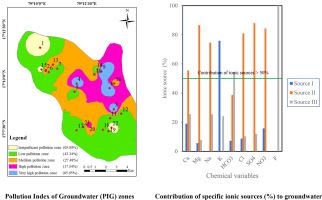Journal of Contaminant Hydrology ( IF 3.6 ) Pub Date : 2022-04-04 , DOI: 10.1016/j.jconhyd.2022.103990 N Subba Rao 1 , A Dinakar 1 , L Sun 2

|
This study aimed to evaluate the degree of groundwater pollution and to assess the contribution of specific ionic sources to groundwater, thereby helping to identify the changes in groundwater chemistry and also in groundwater quality from a rural part of Telangana, India, using the comprehensive understanding of geochemical ratios (GR), pollution index of groundwater (PIG), unmix model (UM), and land use/land cover. Groundwater samples collected (22) from the study area were analysed for pH, EC, TDS, Ca2+, Mg2+, Na+, K+, HCO3−, Cl−, SO42−, NO3−, and F−. The hydrogeochemical diagram showed the dominant groundwater type of Ca2+- Mg2+- HCO3− due to the water-soil-rock interactions. GR, chloro-alkaline indices, and saturation indices revealed the groundwater chemistry that explains the mineral weathering and dissolution, ion exchange, and evaporation processes as the chief geogenic origin, and also the contamination of surface water due to the influence of household wastewater, septic tank leaks, irrigation-return-flows, chemical composts, etc. as the secondary anthropogenic sources on the aquifer system. Changes in groundwater quality from the recharge area to the discharge area and the correlation coefficient of chemical variables further supported the sources of geogenic and anthropogenic origins. According to PIG's calculations, the present study area was classified as the insignificant pollution zone (5.89%), which shows all chemical variables within their drinking water quality limits, and the low pollution zone (43.34%), medium pollution zone (27.48%), high pollution zone (17.34%), and very high pollution zone (5.95%), which exhibit the TDS, Mg2+, Na+, K+, HCO3−, Cl−, NO3−, SO42−, and F−contents above the drinking water quality standards. This indicates the gradual increase in the intensity of pollution activity. UM also classified the contribution of specific ions (>50%) into three sources: Source I (K+) measures the poor sewage conditions and potash fertilizers; Source II (SO42−, Mg2+, NO3−, Na+, and Ca2+) specifies the poor sewage conditions, irrigation-return-flows, and chemical fertilizers (gypsum and nitrate); and Source III (F− and HCO3−) represents the dissolution of fluoride minerals as a major contributor to groundwater chemistry. Furthermore, the land use/land cover observations had also supported the assessment of groundwater pollution levels and the contribution of specific ionic sources made by PIG and UM. As a result, the present study clearly indicated that groundwater quality of a geogenic origin is primarily overcome the impact of anthropogenic sources. Therefore, the present study suggested strategic measures to control groundwater pollution and improve groundwater quality.
中文翻译:

使用地球化学比率、地下水污染指数、非混合模型和土地利用/土地覆盖的综合方法估算地下水污染水平和地下水中的特定离子源——案例研究
本研究旨在评估地下水污染程度并评估特定离子源对地下水的贡献,从而帮助确定印度特伦甘纳邦农村地区地下水化学和地下水质量的变化,利用对地下水的全面了解地球化学比率 (GR)、地下水污染指数 (PIG)、非混合模型 (UM) 和土地利用/土地覆盖。从研究区采集的地下水样品 (22) 分析了 pH、EC、TDS、Ca 2+、Mg 2+、Na +、K +、HCO 3 -、Cl -、SO 4 2-、NO 3 -和F - 。由于水-土壤-岩石相互作用,水文地球化学图显示了主要的地下水类型为Ca 2+ - Mg 2+ - HCO 3 - 。GR、氯碱指数和饱和指数揭示了解释矿物风化和溶解、离子交换和蒸发过程作为主要地质起源的地下水化学,以及由于家庭废水、化粪池的影响而对地表水的污染储罐泄漏、灌溉回流、化学堆肥等作为含水层系统的次要人为来源。补给区至排放区地下水水质变化及相关系数化学变量进一步支持了地质和人为起源的来源。根据 PIG 的计算,本研究区域被划分为微污染区(5.89%),所有化学变量都在其饮用水水质范围内,低污染区(43.34%)、中污染区(27.48%) , 高污染区 (17.34%) 和超高污染区 (5.95%), 表现出 TDS, Mg 2+, Na+, K+, HCO3-, Cl-, NO3-, SO42-,和 F-含量超过饮用水水质标准。这表明污染活动的强度逐渐增加。UM 还将特定离子 (>50%) 的贡献分为三个来源: 来源 I (K + ) 衡量恶劣的污水条件和钾肥;来源 II(SO 4 2-、Mg 2+、NO 3 -、Na +和 Ca 2+ )说明了恶劣的污水条件、灌溉回流和化肥(石膏和硝酸盐);和来源 III(F -和 HCO 3 -) 表示氟化物矿物的溶解是地下水化学的主要贡献者。此外,土地利用/土地覆盖观测也支持了对地下水污染水平的评估以及 PIG 和 UM 所做的特定离子源的贡献。因此,本研究清楚地表明,地质来源的地下水质量主要是克服了人为来源的影响。因此,本研究提出了控制地下水污染和改善地下水质量的战略措施。


























 京公网安备 11010802027423号
京公网安备 11010802027423号